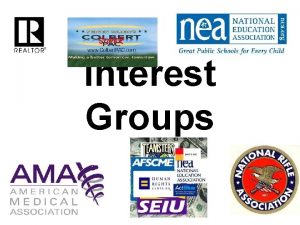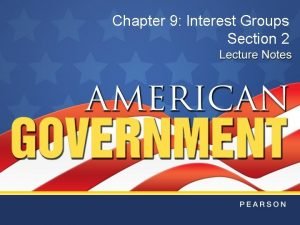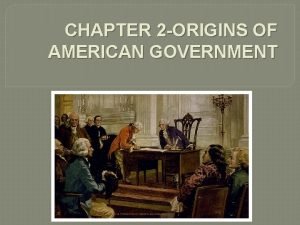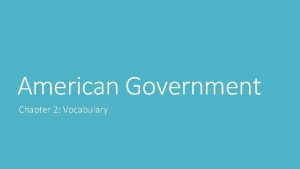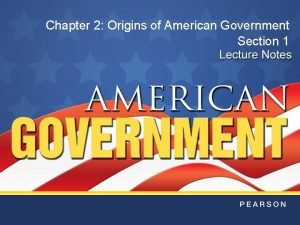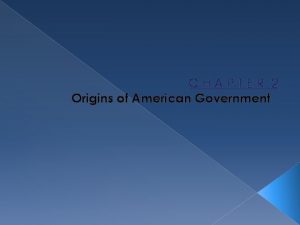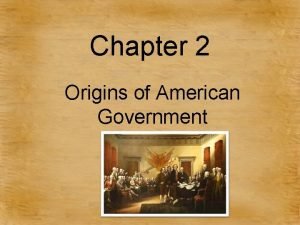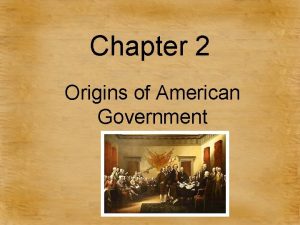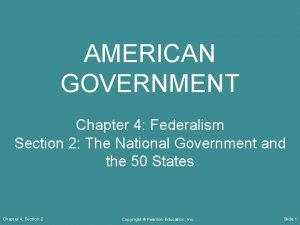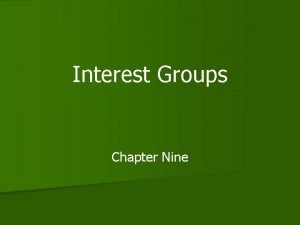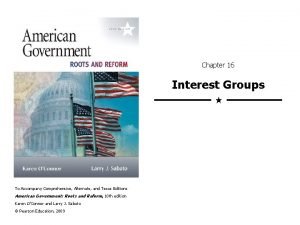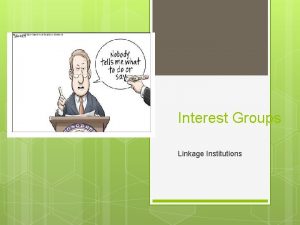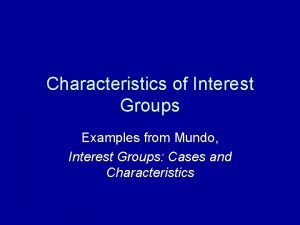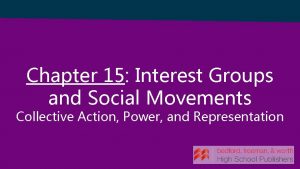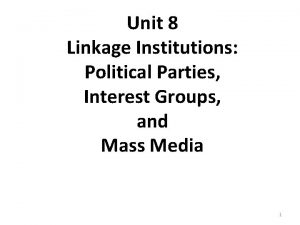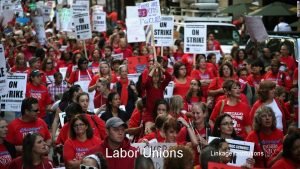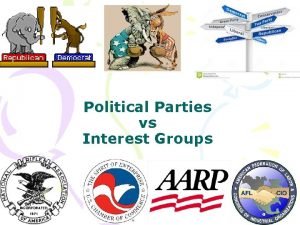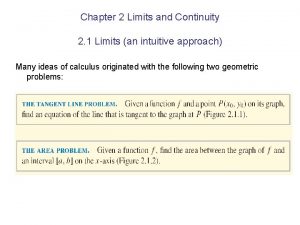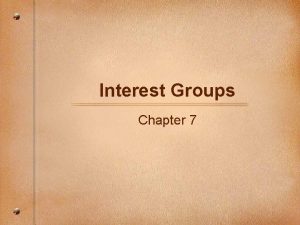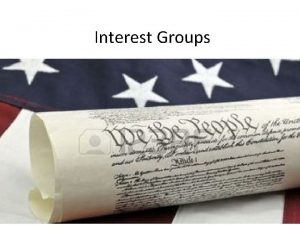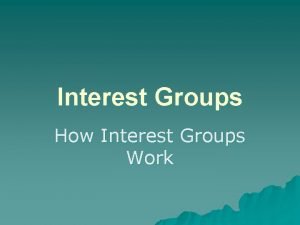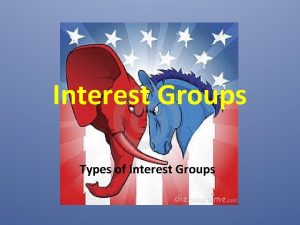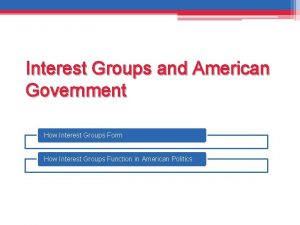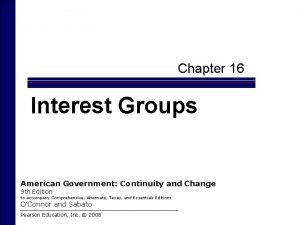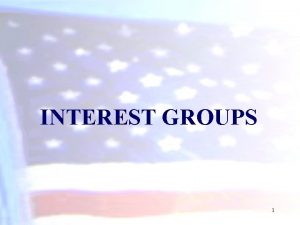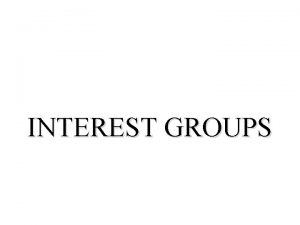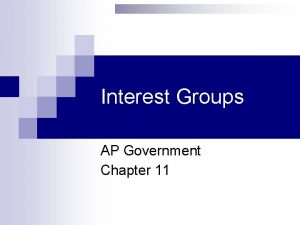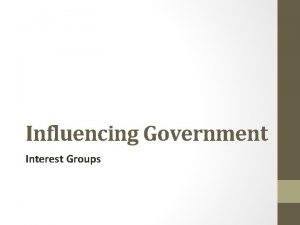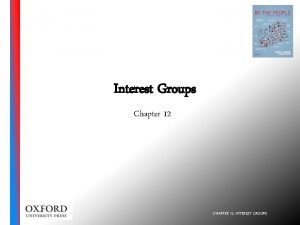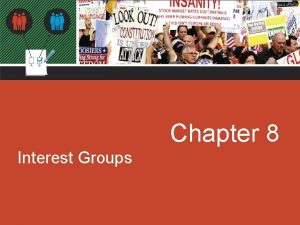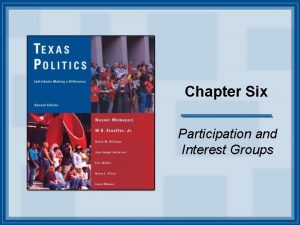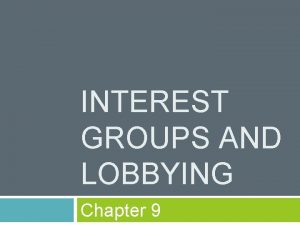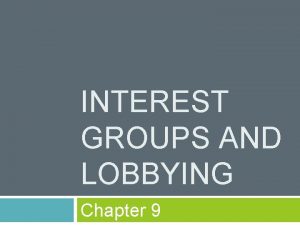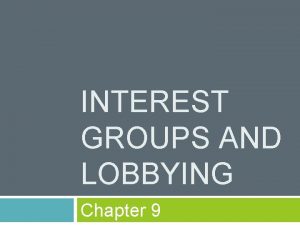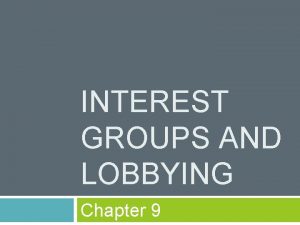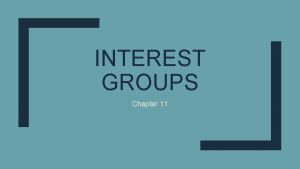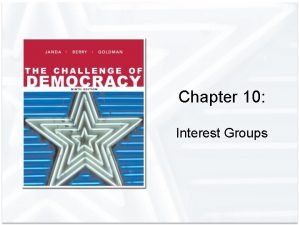Chapter 16 Interest Groups American Government Continuity and



























- Slides: 27

Chapter 16 Interest Groups American Government: Continuity and Change 9 th Edition to accompany Comprehensive, Alternate, Texas, and Essentials Editions O’Connor and Sabato Pearson Education, Inc. © 2008

Interest Groups o Social capital n The myriad relationships that individuals enjoy that facilitate the resolution of community problems through collective action o Civic virtue n The tendency to form small-scale associations for the public good

What are Interest Groups? o An organized group that tries to influence public policy o Truman n Disturbance theory o Interest groups form in part to counteract the efforts of other groups

What Are Interest Groups? o Robert Salisbury n Expanded Truman’s theory n Groups form when resources are inadequate or scarce n Stressed the role that leaders play: entrepreneurs

Kinds of Organized Interests o Generally, interest groups is a term used to describe the numerous organized groups that try to influence government policy o Public Interest Groups o Economic Interest Groups o Governmental Units o Political Action Committees o Multi-Issue versus Single Issue Groups

The Origins & Development of American Interest Groups o National groups emerge (1830 -1889) n Communication networks enabled nationalization of groups n First were single-issue groups deeply rooted in the Christian religious revivalism o Temperance, Peace, Education, and Slavery n Other groups emerged after the Civil War n One of the most effective: Central Pacific Railroad o Sent lobbyist to D. C. in 1861 n Lobbyists o Interest group representative who seeks to influence legislation that will benefit his or her organization through political persuasion


The Roots & Development of American Interest Groups o The Progressive Era (1890 -1920) n Grew out of concern for impact of rapid industrialization, influx of immigration, monopolistic business practices, crime, poverty, poor working conditions n Organized Labor o AFL o Clayton Act: allowed unions to organize free from prosecution and guaranteed their right to strike n Business Groups and Trade Associations o Trade Associations: a group that represents a specific industry o National Electric Light Association (NELA)

The Rise of the Interest Group State o 1960 s and 1970 s saw a reappearance of the Progressive spirit n n n Civil Rights Women’s Rights Elderly Poor Consumers Environment o Common Cause and Ralph Nader’s Public Citizen o Conservative Response: Religious and Ideological Groups n Jerry Falwell and the Moral Majority n Pat Robertson, the 700 Club and the Christian Coalition n National Rifle Association

Business Groups, Corporations, and Associations o Rise in business advocacy groups o More political that Chamber of Commerce n Example: The Business Roundtable o Created in 1972 o Urges member to engage in direct lobbying to influence the course of public policy o Most large corporations have n Own governmental affairs department n Employ D. C. -based lobbyists to keep them apprised of legislation n Gave substantial soft money in the past n Still use PACS, 527 s, and thus contribute a great deal of money

Organized Labor o Began to emerge as powerful player early in the 20 th century n Could turn out members n Focus not only on labor issues, but also other issues of concern to its members o More recently labor has lost some clout n Membership down n “pale, male, stale”



What Do Interest Groups Do? o Lobbying n The activities of a group or organization that seeks to influence legislation and persuade political leaders to support the group’s position n 23 ways for lobbyists and organizations to lobby on the state and national level o Most often they: testify at legislative hearings, contact government officials directly, help draft legislation


Lobbying Congress o Members of Congress targets of lobbyists o Many lobbyists former members o Lobbyists work closely with those members who share their interests o Effectiveness depends on a lobbyists’ reputation for fair play and accurate information



Lobbying the Executive Branch o As the scope of federal government has expanded, so has lobbying of the executive branch. n Many potential access points n Lobbyists seek influence at formation and implementation stages. n An especially strong link exists between interest groups and regulatory agencies n Groups often monitor the implementation of the laws or policies they advocated.

Lobbying the Courts o Can take two forms: n Direct sponsorship n Filing amicus curiae briefs o Brief that informs the court of the group’s policy preferences, generally in guise of legal arguments o Interest groups also attempt to influence who is nominated and placed on the bench.

Grassroots Lobbying o A form of pressure-group activity that attempts to involve individuals who contact their representatives directly in an effort to influence policy o Persuading ordinary voters to act as the group’s advocates

Protest and Radical Activism o Some groups resort to more forceful, legal as well as illegal measures to attract attention to their cause. n Sometimes violent, illegal protest (Boston Tea Party, Shays’ Rebellion) n Civil Rights Movement o Marches with permits legal n PETA n Animal Liberation Front

Attempts to Reform Congressional Lobbying o Federal Regulation of Lobbying Act, 1946 o Lobbying Disclosure Act, 1995 n Employs a strict definition of lobbyist n Requires lobbyists to: o Register with the clerk of the House and the secretary of the Senate o Report their clients and issues and the agency or house they lobbied o Estimate the amount they are paid by each client n Makes it easier for watchdog groups to track the lobbying activity


Election Activities o Candidate recruitment and endorsements o Getting out the vote o Rating the candidates or office holders o Political action committees

What Makes An Interest Group Successful? o Leaders o Patrons and Funding n Person who finances a group or individual activity o Members n Collective goods n Free riders: potential members who fail to join a group because they can get the benefit, or collective good, sought by the group without contributing to it

 Absolute continuity implies uniform continuity
Absolute continuity implies uniform continuity For or against
For or against Chapter 9 section 2 types of interest groups
Chapter 9 section 2 types of interest groups How are ethnic groups and religious groups related
How are ethnic groups and religious groups related Nominal v. real interest rates
Nominal v. real interest rates Compound interest meaning
Compound interest meaning Chapter 2 american government
Chapter 2 american government Origins of american government vocabulary
Origins of american government vocabulary Chapter 2 origins of american government answer key
Chapter 2 origins of american government answer key Chapter 2 origins of american government worksheet answers
Chapter 2 origins of american government worksheet answers Origins of american government chapter 2
Origins of american government chapter 2 Chapter 2 origins of american government
Chapter 2 origins of american government American government chapter 4
American government chapter 4 Free rider interest group
Free rider interest group The nature of interest groups
The nature of interest groups A virtue of interest groups is that
A virtue of interest groups is that Interest groups linkage institutions
Interest groups linkage institutions Proliferation of interest groups
Proliferation of interest groups State two characteristics of interest groups
State two characteristics of interest groups Interest groups vs social movements
Interest groups vs social movements Linkage institutions
Linkage institutions Linkage institutions
Linkage institutions Federalist 10 interest groups
Federalist 10 interest groups What are interest groups
What are interest groups Fundamental goal of interest groups
Fundamental goal of interest groups Effective interest rate
Effective interest rate National government vs federal government
National government vs federal government Limits
Limits

